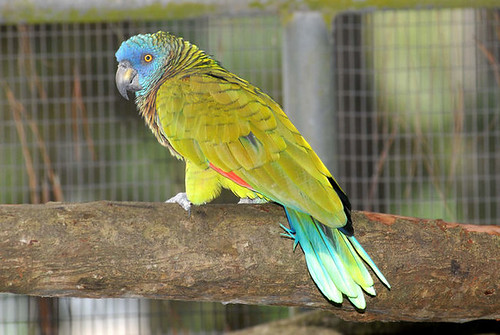 The endangered and colourful Saint Lucia parrot is making a comeback on the island. (Handout Photo)SAINT LUCIA -- A few decades ago, you couldn't go anywhere on this island without hearing about the St. Lucia Parrot. The national bird was the subject of songs, plays, bumper stickers and even appeared on postage stamps.
The endangered and colourful Saint Lucia parrot is making a comeback on the island. (Handout Photo)SAINT LUCIA -- A few decades ago, you couldn't go anywhere on this island without hearing about the St. Lucia Parrot. The national bird was the subject of songs, plays, bumper stickers and even appeared on postage stamps.
There was a good reason for all the attention. The St. Lucia Parrot, which is endemic to the island, was on the verge of extinction. The species had declined from about 1,000 birds in the 1950s to just 150 in the late 1970s. Most experts predicted it would die out by the turn of the century. That's when citizens decided to rally around their parrot -- Amazona Versicolour -- known locally as a "Jacquot."
"The whole nation got involved in trying to save the species," said Jeannine Henry, a guide at the new Our Planet attraction, which has a section devoted to the bird.
The effort involved public education, conservation measures, and stiff fines for anyone who was caught hunting, capturing or harming the bird. It worked, thanks in part to the assistance of the Durrell Wildlife Conservation Trust. By 1990, the species increased to about 350 birds and has been expanding, albeit slowly.
Still, with only about 350 in the wild, my chance of seeing one wasn't high. Many residents told me they had never seen the bird. I didn't let that deter me.
While travelling on the north side of the island one day, my driver Leonard James mentioned a little-known Mini Zoo near Castries, where I could see a few of the parrots. Ten minutes later, we were walking past cages containing iguanas, agoutis, green monkeys and a boa constrictor.
In a large cage, near a sign for the Union Nature Trail, was the St. Lucia Parrot. It sat on its perch and watched me without making a sound, while I admired its resplendent colours -- mainly green with a cobalt-blue forehead and scarlet breast. I was thrilled to see it, though it looked a bit lonely. There was another Jacquot in a similarly sized cage next to it and a third, in a smaller cage on the second floor of the interpretive centre.
 Rain Forest Sky Rides’ aerial tram provides a thrilling new view of Saint Lucia from above the mature rain forest canopy. (Handout photo)In the wild, Jacquots occupy the forest canopy where they feed on fruit, nuts and berries. To increase my chance of a sighting I would have to be on their turf.
Rain Forest Sky Rides’ aerial tram provides a thrilling new view of Saint Lucia from above the mature rain forest canopy. (Handout photo)In the wild, Jacquots occupy the forest canopy where they feed on fruit, nuts and berries. To increase my chance of a sighting I would have to be on their turf.
The Rain Forest Sky Rides sounded promising. One of the attractions is an aerial tram that takes you 39 metres up in the air with a view of a mature rain forest canopy. It was an enjoyable narrated ride amid ficus and gommier trees, ferns and tropical flowers, but there was no sign of the St. Lucia Parrot.
I spent the next few days seeing the sights -- the "drive-in" volcano, Diamond Botanical Gardens, Pigeon Island National Historic Park, and the market in Castries -- and indulging. Particularly notable was dinner at the atmospheric Rainforest Hideaway restaurant and a spa treatment at a seaside hut at Coconut Bay Beach Resort.
I hadn't forgotten about the parrot, though, and on my last day, I planned a hike of the Des Cartier Rain Forest Trail near the village of Micoud. But when we arrived early Sunday morning, there was no sign of our guide. James got on his cell phone to make inquiries, while I stood at the foot of a vine-draped gmelina tree, mentally debating whether I would walk the rugged northern loop trail alone without an interpreter. That's when I heard a bird call that sounded like a parrot.
"That's it," cried James. I ran to the trailhead and began scanning the trees for a glimpse of the bird. And there it was! I couldn't believe my luck!
Using my camera's zoom lens like a pair of binoculars I focused on the parrot, which continued singing, apparently communicating with a parrot in another tree. The air was steamy, and the sky overcast. I craned my head to see the bird, which was in the upper reaches of the canopy. Sometimes it would face in my direction and other times it would turn its back to me. I tried hard to steady the camera, as mosquitoes viciously bit every inch of exposed skin.
Soon, James and groundskeeper Therence Eugene, who showed up in place of the guide, joined me in observing the parrots, helping me locate the birds, each time they flew to a different branch. I wasn't sure if the jacquots were aware of our presence but we kept still just in case. Ten minutes later they were gone.
I was surprised when Eugene told me he sees the parrots almost every day. He says 5:30 a.m. and 5 p.m. are the best times.
I was no longer interested in walking the trail now that I'd glimpsed the rare St. Lucia Parrot in the wild. And to think I'd seen it without the effort of a physically demanding hike. I felt like I had cheated. It was too easy. But rewarding nonetheless.
For travel information, visit the Saint Lucia Tourist Board at stlucianow.com. For Rainforest Sky Rides, see check rfat.com. For Our Planet, check ourplanetcentre.org.